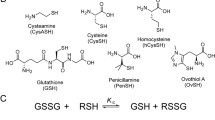Abstract
The health of living systems depends on the proper balance of cellular oxidative and reductive processes (redox balance), which is reflected in the thiol-disulfide balance in cells. Glutathione is the predominant low-molecular-weight thiol in mammalian cells. Through its diverse actions as an antioxidant, as a detoxifier of xenobiotics, and as a regulator of protein function, among others, glutathione is vitally important to cell health. Spectroscopic probes that can act as sensors or reporters of glutathione are, therefore, useful. We report here the synthesis of three new disulfide-linked dinitroxides, whose EPR spectra change dramatically upon reaction with glutathione, and the characterization of the kinetics of their reaction with glutathione.
Access this article
We’re sorry, something doesn't seem to be working properly.
Please try refreshing the page. If that doesn't work, please contact support so we can address the problem.






Similar content being viewed by others
Data Availability
All data required to evaluate the conclusions of the paper are presented in the paper.
Change history
20 July 2021
A Correction to this paper has been published: https://doi.org/10.1007/s00723-021-01359-6
References
J. Santolini, S.A. Wootton, A.A. Jackson, M. Feelisch, Curr. Opin. Physiol. 9, 34–47 (2019)
F.Q. Schafer, G.R. Buettner, Free Radical Biol. Med. 30(11), 1191–1212 (2001)
M. Hornsveld, T.B. Dansen, Antioxid. Redox Signaling 25(6), 300–325 (2016)
J.I. Sbodio, S.H. Snyder, B.D. Paul, Antioxid. Redox Signaling 30(11), 1450–1499 (2019)
J.D. Watson, Lancet 383(9919), 841–843 (2014)
A. Meister, M.E. Anderson, Annu. Rev. Biochem. 52, 711–760 (1983)
I.A. Blair, Curr. Drug Metab. 7(8), 853–872 (2006)
J.D. Hayes, J.U. Flanagan, I.R. Jowsey, Annu. Rev. Pharmacol. Toxicol. 45(1), 51–88 (2004)
Y.M.W. Janssen-Heininger, J.D. Nolin, S.M. Hoffman, J.L. van der Velden, J.E. Tully, K.G. Lahue, S.T. Abdalla, D.G. Chapman, N.L. Reynaert, A. van der Vliet, V. Anathy, J. Cell. Biochem. 114(9), 1962–1968 (2013)
G. Boysen, Chem. Res. Toxicol. 30(5), 1113–1116 (2017)
V.V. Khramtsov, V.I. Yelinova, L.M. Weiner, T.A. Berezina, V.V. Martin, L.B. Volodarsky, Anal. Biochem. 182(1), 58–63 (1989)
V.V. Khramtsov, V.I. Yelinova, I. Glazachev Yu, V.A. Reznikov, G. Zimmer, J. Biochem. Biophys. 32(2), 115–128 (1997)
E.A. Legenzov, S.J. Sims, N.D. Dirda, G.M. Rosen, J.P. Kao, Biochemistry 54(47), 6973–6982 (2015)
B. Epel, S.V. Sundramoorthy, M. Krzykawska-Serda, M.C. Maggio, M. Tseytlin, G.R. Eaton, S.S. Eaton, G.M. Rosen, J.P.Y. Kao, H.J. Halpern, J. Magn. Reson. 276, 31–36 (2017)
A. Fava, A. Iliceto, E. Camera, J Am Chem Soc 79(4), 833–838 (1957)
L. Eldjarn, A. Pihl, Journal of Biolological Chemistry 225(1), 499–510 (1957)
R.M.C. Dawson, Data for Biochemical Research, 3rd edn. (Clarendon Press, Oxford, 1986).
R.B. Martin, J.T. Edsall, Bull. Soc. Chim. Biol. 40(12), 1763–1771 (1958)
D.L. Rabenstein, J Am Chem Soc 95(9), 2797–2803 (1973)
A. Mirzahosseini, M. Somlyay, B. Noszál, Chem. Phys. Lett. 622, 50–56 (2015)
Funding
Supported by the Nanobiology Research Fund of the University of Maryland Baltimore Foundation.
Author information
Authors and Affiliations
Contributions
All authors contributed to the study conception and design. Material preparation, data collection and analysis were performed by MSP, EAL NDAD, GMR, and JPYK. The first draft of the manuscript was written by MSP and JPYK and all authors edited and commented on previous versions of the manuscript. All authors read and approved the final manuscript.
Corresponding author
Ethics declarations
Conflict of Interest
The authors declare no competing interests.
Additional information
Publisher's Note
Springer Nature remains neutral with regard to jurisdictional claims in published maps and institutional affiliations.
The original online version of this article was revised: due to change in figure caption.
Rights and permissions
About this article
Cite this article
Palha, M.S., Legenzov, E.A., Dirda, N.D.A. et al. New Disulfide-Linked Dinitroxides and the Kinetics of Their Reaction with Glutathione. Appl Magn Reson 52, 945–955 (2021). https://doi.org/10.1007/s00723-021-01332-3
Received:
Revised:
Accepted:
Published:
Issue Date:
DOI: https://doi.org/10.1007/s00723-021-01332-3




